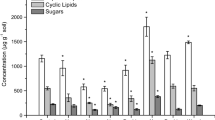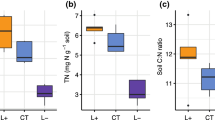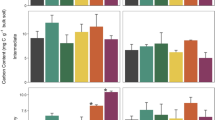Abstract
Models of ecosystem carbon (C) balance generally assume a strong relationship between NPP, litter inputs, and soil C accumulation, but there is little direct evidence for such a coupled relationship. Using a unique 50-year detrital manipulation experiment in a mixed deciduous forest and in restored prairie grasslands in Wisconsin, combined with sequential density fractionation, isotopic analysis, and short-term incubation, we examined the effects of detrital inputs and removals on soil C stabilization, destabilization, and quality. Both forested sites showed greater decline in bulk soil C content in litter removal plots (55 and 66 %) compared to increases in litter addition plots (27 and 38 % increase in surface soils compared to controls). No accumulation in the mineral fraction C was observed after 50 years of litter addition of the two forested plots, thus increases in the light density fraction pool drove patterns in total C content. Litter removal across both ecosystem types resulted in a decline in both free light fraction and mineral C content, with an overall 51 % decline in mineral-associated carbon in the intermediate (1.85–2.4 g cm−3) density pool; isotopic data suggest that it was preferentially younger C that was lost. In contrast to results from other, but younger litter manipulation sites, there was with no evidence of priming even in soils collected after 28 years of treatment. In prairie soils, aboveground litter exclusion had an effect on C levels similar to that of root exclusion, thus we did not see evidence that root-derived C is more critical to soil C sequestration. There was no clear evidence that soil C quality changed in litter addition plots in the forested sites; δ13C and Δ14C values, and incubation estimates of labile C were similar between control and litter addition soils. C quality appeared to change in litter removal plots; soils with litter excluded had Δ14C values indicative of longer mean residence times, δ13C values indicative of loss of fresh plant-derived C, and decreases in all light fraction C pools, although incubation estimates of labile C did not change. In prairie soils, δ13C values suggest a loss of recent C4-derived soil C in litter removal plots along with significant increases in mean residence time, especially in plots with removal of roots. Our results suggest surface mineral soils may be vulnerable to significant C loss in association with disturbance, land use change, or perhaps even climate change over century–decadal timescales, and also highlight the need for longer-term experimental manipulations to study soil organic matter dynamics.







Similar content being viewed by others
References
Battin TJ, Luyssaert S, Kaplan LA, Aufdenkampe AK, Richter A, Tranvik LJ (2009) The boundless carbon cycle. Nat Geosci 2:598–600
Binkley D, Aber J, Pastor J, Nadelhoffer K (1986) Nitrogen availability in some Wisconsin Forests—comparisons of resin bags and on-site incubations. Biol Fertil Soils 2:77–82
Bowden RD, Deem L, Nadelhoffer K, Plante A, Lajtha K (2014) Above and belowground litter Influences on soil organic matter and carbon in a temperate deciduous forest. Soil Sci Soc Am J (in press)
Chung H, Ngo KJ, Plante A, Six J (2010) Evidence for carbon saturation in a highly structured and organic-matter-rich soil. Soil Sci Soc Am J 74:130–138
Clemmensen KE, Bahr A, Ovaskainen O, Dahlberg A, Ekblad A, Wallander H, Stenlid J, Finlay RD, Wardle DA, Lindahl BD (2013) Roots and associated fungi drive long-term carbon sequestration in boreal forest. Science 339:1615–1618
Compton JE, Boone RD (2002) Soil nitrogen transformations and the role of light fraction organic matter in forest soils. Soil Biol Biochem 34:933–943
Crow SE, Lajtha K, Bowden RD, Yano Y, Brant JB, Caldwell BA, Sulzman EW (2009a) Increased coniferous needle inputs accelerate decomposition of soil carbon in an old-growth forest. For Ecol Manag 258:2224–2232
Crow SE, Lajtha K, Filley TR, Swanston CW, Bowden RD, Caldwell BA (2009b) Sources of plant-derived carbon and stability of organic matter in soil: implications for global change. Glob Change Biol 15:2003–2019
Diochon AC, Kellman L (2009) Physical fractionation of soil organic matter: destabilization of deep soil carbon following harvesting of a temperate coniferous forest. J Geophys Res 114:G01016
Drake JE, Darby BA, Giasson M-A, Kramer MA, Phillips RP, Finzi AC (2013) Stoichiometry constrains microbial response to root exudation- insights from a model and a field experiment in a temperate forest. Biogeosciences 10:821–838
Ekschmitt K, Kandeler E, Poll C, Brune A, Buscot F, Friedrich M, Gleixner G, Hartmann A, Kästner M, Marhan S, Miltner A, Scheu S, Wolters V (2008) Soil-carbon preservation through habitat constraints and biological limitations on decomposer activity. J Plant Nutr Soil Sci 171:27–35
Fang C, Smith P, Moncrieff JB, Smith JU (2005) Similar response of labile and resistant soil organic matter pools to changes in temperature. Nature 433:57–59
Fekete I, Kotroczó Z, Varga C, Nagy PT, Tóth JA, Bowden RD, Várbíró G, Lajtha K (2014) Alterations in forest detritus input influence soil carbon concentration and soil respiration in a Central-European deciduous forest. Soil Biol Biochem (in press)
Field CB, Raupach MR (eds) (2004) The global carbon cycle: integrating humans, climate, and the natural world. Island Press, Washington, DC, p 529
Foley JA, Ramankutty N (2004) A primer on the terrestrial carbon cycle: what we don’t know but should. In: Field CB, Raupach MR (eds) The global carbon cycle: integrating humans, climate and the natural world. Island Press, Washington, DC, p 529
Giardina CP, Ryan MG (2000) Soil warming and organic carbon content. Nature 408:789–790
Gottschalk P, Smith JU, Wattenbach M, Bellarby J, Stehfest E, Arnell N, Osborn TJ, Jones C, Smith P (2012) How will organic carbon stocks in mineral soils evolve under future climate? Global projections using RothC for a range of climate change scenarios. Biogeosciences 9:3151–3171
Hatton P-J, Kleber M, Zeller B, Moni C, Plante AF, Townsend K, Gelhaye L, Lajtha K, Derrien D (2012) Transfer of litter-derived N to soil mineral-organic associations: evidence from decadal 15 N tracer experiments. Org Geochem 42:1489–1501
Hoosbeek MR, Scarascia-Mugnozza GE (2009) Increased litter build up and soil organic matter stabilization in a poplar plantation after 6 years of atmospheric CO2 enrichment (FACE): final results of POP-EuroFACE compared to other forest FACE experiments. Ecosystems 12:220–239
Hua Q, Barbetti M (2004) Review of tropospheric bomb 14C data for carbon cycle modeling and age calibration purposes. Radiocarbon 46:1273–1298
Jobbágy EG, Jackson RB (2000) The vertical distribution of soil organic carbon and its relation to climate and vegetation. Ecol Appl 10:423–436
John B, Yamashita T, Ludwig B, Flessa H (2005) Storage of organic carbon in aggregate and density fractions of silty soils under different types of land use. Geoderma 128:63–79
Kaiser K, Guggenberger G (2003) Mineral surfaces and soil organic matter. Eur J Soil Sci 54:219–236
King AW, Post WM, Wullschleger SD (1997) The potential response of terrestrial carbon storage to changes in climate and atmospheric CO2. Clim Change 35:199–227
Kramer C, Trumbore S, Fröberg M, Dozal LMC, Zhang D, Xu X, Santos GM, Hanson PJ (2010) Recent (<4 year old) leaf litter is not a major source of microbial carbon in a temperate forest mineral soil. Soil Biol Biochem 42:1028–1037
Kramer MG, Sanderman J, Chadwick OA, Chorover J, Vitousek PM (2012) Long-term carbon storage through retention of dissolved aromatic acids by reactive particles in soil. Glob Change Biol 18:2594–2605
Kucharik CJ, Fayram NJ, Cahill KN (2006) A paired study of prairie carbon stocks, fluxes, and phenology: comparing the world’s oldest prairie restoration with an adjacent remnant. Glob Change Biol 12:122–139
Kuzyakov Y (2002) Review: factors affecting rhizosphere priming effects. J Plant Nutr Soil Sci 165:382–396
Kuzyakov Y, Friedel JK, Stahr K (2000) Review of mechanisms and quantification of priming effects. Soil Biol Biochem 32:1485–1498
Lajtha K, Peterson F, Nadelhoffer K, Bowden R (2013) Twenty years of litter and root manipulations: insights into multi-decadal som dynamics. Soil Sci Soc Am J 67:1418–1427
Leifeld J, Fuhrer J (2005) The temperature response of CO2 production from bulk soils and soil fractions is related to soil organic matter quality. Biogeochemistry 75:433–453
Liski J, Perruchoud D, Karjalainen T (2002) Increasing carbon stocks in the forest soils of western Europe. For Ecol Manag 169:159–175
Llorente M, Glaser B, Turrión MB (2010) Storage of organic carbon and Black carbon in density fractions of calcareous soils under different land uses. Geoderma 159:31–38
Mayzelle MM, Krusor ML, Bowden RD, Lajtha K, Six JW (2014) The effects of decreasing carbon saturation deficit on temperate forest soil carbon cycling. Soil Sci Soc Am J (in press)
McFarlane KJ, Schoenholtz SH, Powers RF, Perakis SS (2010) Soil Organic Matter Stability in Intensively Managed Ponderosa Pine Stands in California. Soil Sci Soc Am J 74:979–992
McLauchlan KK, Hobbie SE (2004) Comparison of labile soil organic matter fractionation techniques. Soil Sci Soc Am J 68:1616–1625
Melillo JM, McGuire AD, Kicklighter DW, Moore BI, Vorosmarty CJ, Schloss AL (1993) Global climate change and terrestrial net primary production. Nature 363:234–240
Mendez-Millan M, Dignac M-F, Rumpel C, Rasse DP, Derenne S (2010) Molecular dynamics of shoot versus root biomarkers in an agricultural soil estimated by natural abundance 13C labelling. Soil Biol Biochem 42:169–177
Nielsen GA, Hole FD (1963) A study of the natural processes of incorporation of organic matter into soil in the University of Wiscosnsin Arboretum. Wis. Acad. Rev. 52:213–227
Parfitt RL, Parshotam AA, Salt GJ (2002) Carbon turnover in two soils with contrasting mineralogy under long-term maize and pasture. Aust J Soil Res 40:127–136
Paul KI, Polglase PJ, Richards GP (2003) Predicted change in soil carbon following afforestation or reforestation, and analysis of controlling factors by linking a C accounting model (CAMFor) to models of forest growth (3PG), litter decomposition (GENDEC) and soil C turnover (RothC). For Ecol Manag 177:485–501
Plante AF, Conant RT, Stewart CE, Paustian K, Six J (2006) Impact of soil texture on the distribution of soil organic matter in physical and chemical fractions. Soil Sci Soc Am J 70:287–296
Post WM, Peng T-H, Emanuel WR, King AW, Dale VH, DeAngelis DL (1990) The global carbon cycle. Am Sci 78:310–326
Raich JW, Schlesinger WH (1992) The global carbon dioxide flux in soil respiration and its relationship to vegetation and climate. Tellus 44:81–99
Raich JW, Russell AE, Kitayama K, Parton WJ, Vitousek PM (2006) Temperature influences carbon accumulation in moist tropical forests. Ecology 87:76–87
Rasse DP, Rumpel C, Dignac M-F (2005) Is soil carbon mostly root carbon? mechanisms for a specific stabilisation. Plant Soil 269:341–356.
Reimer PJ, Brown TA, Reimer RW (2004) Reporting and calibration of post-bomb 14C data. Radiocarbon 46:1299–1304
Richter DD, Markewwitz D, Trumbore SE, Wells CG (1999) Rapid accumulation and turnover of soil carbon in a re-establishing forest. Nature 400:56–58
Schlesinger WH, Andrews JA (2000) Controls on soil respiration: implications for climate change. Biogeochemistry 48:7–20
Schmidt MWI, Torn MS, Abiven S, Dittmar T, Guggenberger G, Janssens IA, Kleber M, Kogel-Knabner I, Lehmann J, Manning DAC, Nannipieri P, Rasse DP, Weiner S, Trumbore SE (2011) Persistence of soil organic matter as an ecosystem property. Nature 478:49–56
Six J, Conant RT, Paul EA, Paustian K (2002) Stabilization mechanisms of soil organic matter: implications for C-saturation of soils. Plant Soil 241:155–176
Sollins P, Swanston C, Kleber M, Filley T, Kramer M, Crow S, Caldwell B, Lajtha K, Bowden R (2006) Organic C and N stabilization in a forest soil: evidence from sequential density fractionation. Soil Biol Biochem 38:3313–3324
Sollins P, Kramer MG, Swanston C, Lajtha K, Filley T, Aufdenkampe AK, Wagai R, Bowden RD (2009) Sequential density fractionation across soils of contrasting mineralogy: evidence for both microbial- and mineral-controlled soil organic matter stabilization. Biogeochemistry 96:209–231
Stewart CE, Paustian K, Conant RT, Plante AF, Six J (2009) Soil carbon saturation: implications for measurable carbon pool dynamics in long-term incubations. Soil Biol Biochem 41:357–366
Stuiver M, Polach HA (1977) Reporting of C-14 data. Radiocarbon 19:355–363
Sulzman EW, Brant JB, Bowden RD, Lajtha K (2005) Contribution of aboveground litter, belowground litter, and rhizosphere respiration to total soil CO2 efflux in an old growth coniferous forest. Biogeochemistry 73:231–256
Throop HL, Lajtha K, Kramer M (2013) Density fractionation and 13C reveal changes in soil carbon following woody encroachment in a desert ecosystem. Biogeochemistry 112:409–422
Torn MS, Trumbore SE, Chadwick OA, Vitousek PM, Hendricks DM (1997) Mineral control of soil organic carbon storage and turnover. Nature 389:170–173
Torn MS, Swanston CW, Castanha C, Trumbore S (2009) Storage and turnover of organic matter in soil. In: Huang PM, Senesi N (eds) Biophysico-chemical processes involving natural nonliving organic matter in environmental systems. Wiley, Hoboken, pp 219–272
Townsend AR, Vitousek PM, Desmarais DJ, Tharpe A (1997) Soil carbon pool structure and temperature sensitivity inferred using CO2 and 13CO2 incubation fluxes from five Hawaiian soils. Biogeochemistry 38:1–17
Trumbore S (2006) Carbon respired by terrestrial ecosystems—recent progress and challenges. Glob Change Biol 12:141–153
Wynn JG, Bird MI, Vellen L, Grand-Clement E, Carter J, Berry SL (2006) Continental-scale measurement of the soil organic carbon pool with climatic, edaphic, and biotic controls. Global Biogeochem Cycles 20:GB1007
Acknowledgments
This study was supported in part by NSF Grants 0817064 and 1257032. We thank Kevin McSweeney and Brad Herrick for assistance in the field and granting us permission to sample in the plots, Fox Peterson for statistical and editorial help, and Jim LeMoine for laboratory help.
Author information
Authors and Affiliations
Corresponding author
Additional information
Responsible Editor: Sharon A. Billings
Appendix
Appendix
Rights and permissions
About this article
Cite this article
Lajtha, K., Townsend, K.L., Kramer, M.G. et al. Changes to particulate versus mineral-associated soil carbon after 50 years of litter manipulation in forest and prairie experimental ecosystems. Biogeochemistry 119, 341–360 (2014). https://doi.org/10.1007/s10533-014-9970-5
Received:
Accepted:
Published:
Issue Date:
DOI: https://doi.org/10.1007/s10533-014-9970-5




